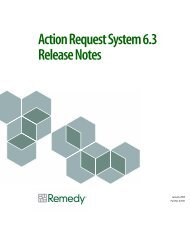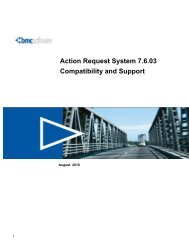BMC Remedy Action Request System 7.6.04: BMC Remedy Mid Tier ...
BMC Remedy Action Request System 7.6.04: BMC Remedy Mid Tier ...
BMC Remedy Action Request System 7.6.04: BMC Remedy Mid Tier ...
You also want an ePaper? Increase the reach of your titles
YUMPU automatically turns print PDFs into web optimized ePapers that Google loves.
<strong>BMC</strong> <strong>Remedy</strong> <strong>Action</strong> <strong>Request</strong> <strong>System</strong> <strong>7.6.04</strong><br />
Importing the definition files<br />
88 <strong>BMC</strong> <strong>Remedy</strong> <strong>Mid</strong> <strong>Tier</strong> Guide<br />
Import the definition files into your home page server. Definition files of different<br />
locales are installed with the mid tier; the default location is:<br />
mid<strong>Tier</strong>InstallDir\samples\AR<strong>System</strong><strong>Mid</strong><strong>Tier</strong>ObjectList*.def<br />
Import the AR<strong>System</strong><strong>Mid</strong><strong>Tier</strong>ObjectList.def file to your home page server by<br />
using File > Import in <strong>BMC</strong> <strong>Remedy</strong> Developer Studio. This provides the default<br />
view and the related workflow in English. If you require only the English view of<br />
the form, import only this file.<br />
For a localized views, import the appropriate localized .def files. Browse to the<br />
samples directory, and select the .def file for the locale that you require. The<br />
naming convention is:<br />
AR<strong>System</strong><strong>Mid</strong><strong>Tier</strong>ObjectList_locale.def<br />
For example, for Japanese views, the file is called<br />
AR<strong>System</strong><strong>Mid</strong><strong>Tier</strong>ObjectList_ja.def.<br />
Displaying the Object List<br />
After it is enabled, the AR <strong>System</strong> Object List appears automatically in the user’s<br />
browser if the system cannot determine which form to load because of an<br />
incomplete or incorrect URL, or if the URL specifies an application that does not<br />
have a primary form. (For more information about specifying a primary form in an<br />
application, see the Form and Application Objects Guide, “Defining applications,”<br />
page 85.)<br />
You can also display the AR <strong>System</strong> Object List by using any of the following<br />
URLs:<br />
http://mid<strong>Tier</strong>Server/arsys/forms<br />
http://mid<strong>Tier</strong>Server/arsys/forms/serverName<br />
http://mid<strong>Tier</strong>Server/arsys/apps<br />
http://mid<strong>Tier</strong>Server/arsys/apps/serverName<br />
http://mid<strong>Tier</strong>Server/arsys/apps/serverName/applicationName<br />
Browser settings for scripting and ActiveX<br />
controls<br />
For the mid tier to work properly, the ActiveX settings for the XMLHTTP protocol<br />
between the browsers and mid tier must be set correctly.<br />
Typically, if you use all the default scripting settings in Microsoft Internet Explorer<br />
and Mozilla Firefox browsers, you should not see any problems with the mid tier.<br />
Otherwise, enable the following ActiveX settings for your browser.





